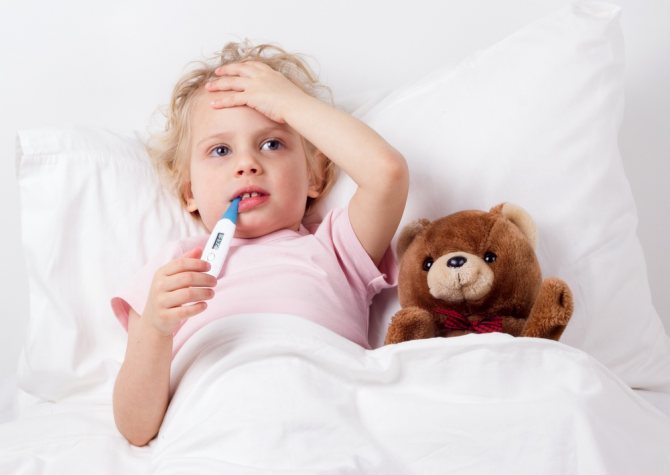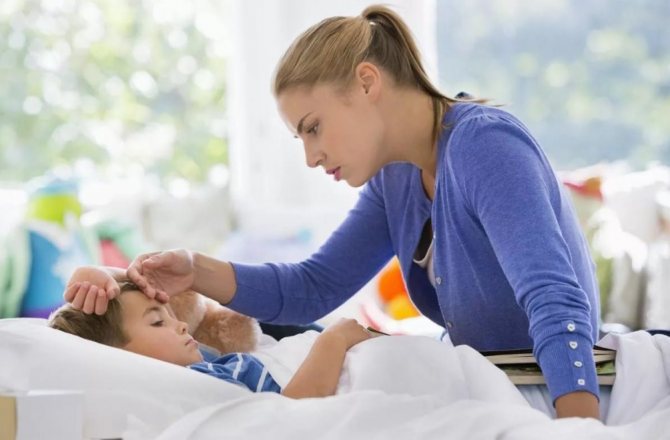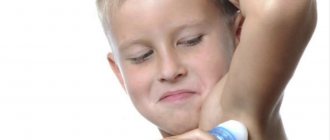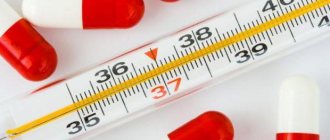According to doctors, high temperature should be treated as an auxiliary factor, the participation of which should be timely and short-lived. However, most often this symptom that occurs in a child causes panic in his parents, and therefore all efforts are directed towards eliminating it. The article will discuss the reasons why a child develops a temperature of 40, what to do in this case, what actions it is better to refrain from, and whether it is necessary to bring down the fever.
A child's fever is a natural cause for concern for every parent.
Temperature 40 in a child
The occurrence of fever is a normal (and even necessary) reaction of the body to pathology, which strives for self-healing. In this way, it fights infection and harmful substances that have entered the body. Since fever is a symptom of a disease, when it occurs, it is necessary to deal, first of all, with eliminating the cause (that is, pathology), and not the effect (fever). It is important to remember that sometimes high temperature is still dangerous to the life and health of the patient. In such cases, it is necessary to lower it and seek qualified help as soon as possible.
Elevated body temperature can be divided into several categories:
- Mild fever (38-38.5 °C);
- Moderate (38.6-39.5 °C);
- Strong (above 39.5 °C);
- Critical level (above 40.5-41).
On a note. The reaction of the child’s body is individual in each case. If a child, for example, suffers from cardiovascular disease, even a slight fever can pose a threat to him.

High temperature is a sign of normal functioning of the immune system
Fever in children in itself does not pose a threat to life and health. It is a stimulant of the body's immune system. Children from a very early age can lower their temperature above 38.5 degrees with the help of antipyretics. One way or another, if the thermometer readings reach 39.5-40 degrees, the child should be shown to a doctor.
A child requires immediate medical attention in the following cases:
- In an infant 3 months of age or younger, the rectal temperature is 38 degrees or higher;
- The high temperature does not go down with the help of medicines and rubdowns;
- The child has a petechial rash;
- The baby begins to become dehydrated;
- The child cries all the time.
High temperature in children
Children of the first years of life tolerate increased temperature worse than adolescents. Therefore, the first task of parents is to carefully monitor the child’s behavior, his skin, and periodically measure the temperature. In addition, ensure your baby drinks plenty of fluids, dress him in light cotton pajamas, and turn off all eye and ear irritants. That is, during this period, doctors recommend a calm environment - turn off the TV and unnecessary lighting elements. High temperatures at different ages have their own characteristics:
• In newborns, the reaction to an increase in temperature is not yet perfect. However, only in isolated cases can it accompany the development of an infection in the body or an inflammatory process. • In children under one year of age, the heat transfer system is not yet sufficiently developed. • In children under 3 years of age, heat loss exceeds heat production, so hypothermia can cause illness.
Possible reasons
A high thermometer reading indicates that an inflammatory process is occurring in the child’s body. A variety of factors can cause this reaction:
- Babies under 3 months of age are not yet able to perfectly regulate their bodies. Therefore, if you wrap a baby in several layers of clothing or in a very thick blanket, the body may not be able to cope with thermoregulation, and the baby will develop a fever.
- Infection. This is the most common reason. A high temperature indicates that the body is actively fighting viruses or bacteria.
- Graft. To put it exaggeratedly, when a child is vaccinated, a small amount of infection is introduced into his body. This is done so that the immune system learns to cope with viruses and bacteria. The temperature in this case may rise because the body reacts to the vaccine as if it were a normal disease.
- Heatstroke. If a child overheats in the sun or in a stuffy room, his body temperature can rise to 40 degrees or even higher. He develops weakness, dizziness, increased heart rate, and no sweating.
The most common cause is infectious diseases:
- Inflammation of the soft palate. Occurs due to contact with dry air and pathogenic organisms. The disease is characterized by a sore throat, cough (especially in the morning), and hoarseness.
- Laryngitis. Often found in infants. The disease can cause a baby to have a temperature of 40.
- Tracheitis. Causes a prolonged dry cough (especially in the morning). Sometimes sputum may come out. The disease is provoked by contact with damp air or infectious agents.
- Angina. Accompanied by severe sore throat, redness of the mucous membrane, cough.
- Inflammation of the bronchi. There is a severe cough with the release of a small amount of sputum, pain in the chest.
- Pneumonia. Accompanied by severe breathing difficulties.
- Tonsillitis. Characterized by sore throat and discharge of pus.
Viral pathologies that can cause a child’s temperature to rise to 40 degrees include:
- Flu. Accompanied by cough, sore throat, muscles, eyeballs, and aching bones. The disease is unpredictable and can cause serious complications.
- ARVI. A general diagnosis that includes many viral infections.
Diseases that involve damage to internal organs can also cause high fever in a child:
- Pyelonephritis, nephritis.
- Ulcer, colitis.
- Arthritis.
This list includes only a small part of the possible causes of high temperature.
The causes of fever include hormonal disorders:
- Damage to the nuclei of the hypothalamus (a provoking factor may be the appearance of a tumor in the brain).
- Problems with the thyroid gland. In particular, hyperthyroidism leads to excessive production of hormones, causing the body temperature to rise significantly.

There are many causes of fever
Parents' actions at high temperatures
Pediatricians recommend lowering temperatures above 38.5 degrees. You can do this in the following ways:
- Give your child more water. Drinks should be at room temperature.
- Apply cool compresses. To do this, wet a towel, wring it out and place it on your forehead. You should also wipe your armpits, temples and neck. Due to the evaporation of moisture from the surface of the skin, the body will begin to cool and the child will feel better.
You should know! Rubbing with alcohol or vinegar is ineffective.
- Wipe the body with warm water.
- Maintain bed rest.
- Give the patient an antipyretic medicine. This could be Paracetamol or Ibuprofen. These drugs are actively used in pediatric practice. The form of the product varies (tablets, suspensions, suppositories, syrups). The choice depends on the individual characteristics of the body and the symptoms of the disease. Suppositories and suspensions are most often given to young children. Dosage is usually prescribed by weight.
- If febrile seizures are observed, you should immediately call an ambulance. Before the doctors arrive, the child is placed on his side, his head is pulled back and care is taken to ensure that the tongue does not retract.
- It is not necessary to bring the temperature readings to normal. A sharp drop in temperature can negatively affect the child’s well-being. You should not expect an immediate effect from the drugs.
- If the temperature does not go down for a long time, you need to call a pediatrician. The doctor will make a diagnosis and conduct research (for example, a clinical blood test, a general urine test). An ambulance should be called only if there is a clear need, since the child will most likely be given a lytic mixture to eliminate the fever. The fact is that the drug has a number of side effects and interferes with obtaining accurate blood tests.
- The doctor should be called if the child has other complaints (except fever). The same should be done if the temperature rises to 40 in a one-year-old child. An increase in temperature even to 38 degrees in infants under 3 months requires mandatory examination by a specialist.
- If a child with a high fever has cold arms and legs, then there is no reason to panic. This is a symptom of the so-called peripheral vasospasm, in which blood concentrates in the area of the brain and heart. In this case, the child can be given a massage, rubbing, and put warm socks on his feet. It is better to avoid using vasodilator drugs.
- Do not neglect folk remedies.

Compress is an excellent way to reduce fever
What not to do
If a child’s temperature rises to 40 degrees, you should not resort to measures such as:
- Wrap your baby in multiple blankets or otherwise try to keep him warm. Excessive insulation does not allow sweat to evaporate and thereby prevents the body from cooling.
- Heat or humidify the air in the room. Such conditions make it easier for bacteria to enter the respiratory tract. In addition, high humidity prevents sweat from evaporating. Drafts must be excluded.
- Use mustard plasters, alcohol compresses, take hot baths or showers, and drink hot drinks.
- Drink sugary drinks.
- Cool the body by rubbing it with vodka or alcohol. The evaporation of these fluids from the surface of the body occurs too quickly, as a result of which the baby’s body may experience stress and his condition will worsen.
An increase in a child's body temperature to 40 degrees is a reason for a medical examination. At the same time, it is not necessary to call an ambulance in all cases - most often it is enough to consult a pediatrician. Parents can also take independent steps to eliminate fever in their child per year at home (including using folk remedies to eliminate fever). If the child’s temperature rises above 40, then you need to call an ambulance.
Temperature in a newborn baby
It often happens that a mother, who has just returned from the maternity hospital, measures the baby’s temperature, sees the number 37.5˚C on the thermometer, gives the child paracetamol, measures the temperature again and realizes that there is no effect.
If the baby willingly takes the breast, does not worry, the umbilical wound is not red, everything is fine with the baby.
Newborn children adapt to life in this imperfect world; their organ systems also adapt, including thermoregulation processes.
Before giving your child medicine, undress him completely, remove the diaper, put a diaper on him, if you are worried about the furniture, check the temperature in the room where the baby is. It should be 18 - 22˚С. Ventilate the room and measure the temperature again. If the actions have an effect, most likely you are overheating the child. If not, watch your child. Perhaps he was crying or was quite active at the time of taking the temperature or before it, or the baby recently ate. These facts also lead to an increase in body temperature.
If you are also concerned about nasal congestion, change in stool color, severe anxiety in the child, redness of the umbilical wound or discharge from it, it is better to consult a doctor.
And of course, you need to call a doctor if the newborn’s temperature is 38˚C or higher.
There is another group of children whose parents should be more wary than usual. These are children with somatic pathologies. Such as congenital heart defects, cardiac arrhythmias, epilepsy, central nervous system diseases, thyroid diseases, children who have previously had febrile seizures. These children have to bring down the temperature, which has not reached 38.5˚C. The tactics for reducing the temperature of these children are the same as for everyone else, only with lower numbers. And it is advisable to reduce the temperature of these children sharply.










